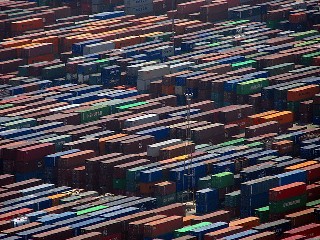 Through slow steaming and idling, shipping lines have managed to cope with overcapacity, weak demand, and severe net losses. But these tactics have not completely stemmed the money-letting because they do not address the root of the problem, says Drewry Maritime Research.
Through slow steaming and idling, shipping lines have managed to cope with overcapacity, weak demand, and severe net losses. But these tactics have not completely stemmed the money-letting because they do not address the root of the problem, says Drewry Maritime Research.
“Most carriers are still losing money despite the costs savings from lower bunker prices and fuel consumption so their capacity management cannot be considered a complete success, although the insistence to carry on ordering big new ships is the prime hindrance on that front,” it said.
Shipping lines once maximized vessel capacity by simply deploying the biggest ships at full speed to minimize the vessel count. It created a win-win scenario for carrier and shipper, aligning carrier profitability with service quality and fast transit times.
The global financial crisis and hugely inflated fuel prices shattered those bedrock assumptions of how to operate liner services, and ever since it has been much more cost effective to operate more ships at lower speeds, said Drewry.
Lay-ups are also another option for carriers that prefer to keep ships trading even when conditions are so bad that cargo is not fully compensating direct costs. Drewry estimates that the idle fleet is now equivalent to around 3 percent of the cellular fleet with the non-operating owners bearing most of the pain.
Recent cargo roll-overs jar with the overcapacity issue, but shippers wouldn’t be left waiting for shipments if the latent capacity was unleashed. “The sub-optimal use of carriers’ biggest assets was essential to reduce voyage costs but shippers are paying the price with longer transits and delays in peak cargo months,” said Drewry.
While carriers have done a good job of absorbing excess capacity into the system, the foundations of their recovery “are rooted in inefficiencies and as such are fragile,” it added. “The large orderbook means they will need to intensify their efforts and shippers should prepare for longer transits and more frequent use of blank voyages.”
To measure the effectiveness of carriers’ capacity management tactics, Drewry compared the current supply-demand situation with what it would have been if idling and slow steaming had not been adopted.
The result shows that total effective capacity has only grown by 22 percent since 2008, whereas at “full speed” the global capacity would have grown by 40 percent over the same period. In 2013 alone, slow steaming and lay-ups reduced available supply by nearly 3 million TEUs, or 20-foot-equivalent units of containers.
Drewry estimates that throughout 2013, blank voyages cut monthly one-way capacity in the Asia-North Europe trade by an average 2.5 percent.
“Put all these factors together and the chance of cargo roll-overs in peak cargo months is greatly increased,” it said further. “Through the sub-optimal deployment of assets, carriers have been relatively successful in reducing voyage costs and raising ship utilization. However, this policy is at times excessive and detrimental to shippers.”
Photo: Ramon Llorensi




